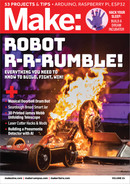
After Make: editor Keith Hammond saw my
latest scientific paper, he suggested that I
devote a column to how I do science without
formal training. (My sole degree is a BA in
government and English from Texas A&M.)
That paper is “A 30-Year Climatology (1990–
2020) of Aerosol Optical Depth and Total Column
Water Vapor and Ozone over Texas” (Bulletin of the
American Meteorological Society, January 2022,
doi.org/10.1175/BAMS-D-21-0010.1). The paper
details 30 years of sun measurements from the
field outside my rural office (Figure
A
). Included
are seven charts speckled with thousands of data
points that depict the recovery of the ozone layer
over my Texas site since the historic volcanic
eruption of Mount Pinatubo in 1991. Other charts
depict a slight reduction in the atmosphere’s
aerosol optical depth (haze) and the absence of a
trend in total column water vapor.
The reduction in haze, which is also obvious in
thousands of sun and sky photos made during
measurement sessions, is likely due to the
closure of many coal-fired power plants. Since
global warming models assume an increase
in total water vapor over time, the absence of a
trend in water vapor was surprising.
The accuracy of the LED sun photometer
that made the measurements was supported
by a nearby NOAA GPS receiver, and a NASA
AERONET site in Oklahoma found a decline in
water vapor over 24 years. Reductions in total
water vapor across North China and the Central
U.S. have also been reported.
Surprises like the absence of a long-term
water vapor trend are what make science
projects so fascinating. You never know what
might be discovered. If you have an interest or
experience in, say, culturing bacteria, or working
with chemicals, building electronic or mechanical
devices, you are already equipped with the basic
skills to pursue a science project.
STUDENT EXPERIMENTS
My science adventures began while watching an
oscillating fan during a seventh-grade class in
1957, when schools were not air conditioned. That
fan suggested to me a method for controlling
the flight of a rocket without using fins. Air would
enter a forward-facing port in the nose cone
Forrest Mims and his many atmospheric instruments.
and be ejected from the side of the nose cone to
provide course changes. While I was unequipped
to implement this daydream design, it led to a
series of career-changing projects.
During high school, I experimented with
simple analog circuits using potentiometers to
add numbers. This led to the idea that a pot is
really a manually programmable memory device.
That idea culminated in an analog computer that
could be programmed to translate 20 words of
various languages into English (makezine.com/
go/homebrew-analog-computer). I donated
it to the Smithsonian Institution after their
mathematics curator visited to collect my early
hobby computer documents. She described the
language translator as an early example of hobby
computing.
My great-grandfather unknowingly inspired
another project. He was blinded by an explosion
while working on a railroad bed in 1906. I’ll
never forget how he tapped his cane to hear
echoes from power poles when we walked along
a country road. That walk inspired the goal of
developing a handheld travel aid for the blind
when I was a senior at Texas A&M in May 1966.
Texas Instruments had just developed powerful
infrared (IR) LEDs, and they provided three of the
expensive devices for my travel aid project.
FORREST M. MIMS III is an amateur scientist
and Rolex Award winner, was named by
Discover magazine as one of the “50 Best Brains
in Science.” He has measured sunlight and the
atmosphere since 1988. forrestmims.org
103
make.co
A
Mark Langford, Minnie C. Mims
M81_102-7_AmSci_F1.indd 103M81_102-7_AmSci_F1.indd 103 4/12/22 12:44 PM4/12/22 12:44 PM
..................Content has been hidden....................
You can't read the all page of ebook, please click here login for view all page.
